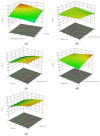Ultrasonic Extraction of 2-Acetyl-1-Pyrroline (2AP) from Pandanus amaryllifolius Roxb. Using Ethanol as Solvent
- PMID: 35956856
- PMCID: PMC9370269
- DOI: 10.3390/molecules27154906
Ultrasonic Extraction of 2-Acetyl-1-Pyrroline (2AP) from Pandanus amaryllifolius Roxb. Using Ethanol as Solvent
Abstract
2-acetyl-1-pyrroline (2AP) is the compound that gives out the typical aroma and flavour of pandan leaves (Pandanus amaryllifolius Roxb.). This research incorporates ultrasonic extraction to extract the aromatic compound in pandan leaves. The parameters varied in this study are the extraction time, sonicator amplitude, concentration of solvent and the mass of pandan leaves. The experiment was conducted using a central composite design (CCD) model generated by the response surface methodology (RSM). From the extraction process, it can be deduced that the effect of leaves' mass is comparably higher than other parameters, while sonicator amplitude gives the most negligible impact on the process. The obtained p-value was 0.0014, which was less than 0.05. The high R-squared 0.9603 and adjusted R-squared 0.8809 indicate the model is well agreed with the actual data. The optimal control variables of ultrasonic extraction of 2AP are at an extraction time of 20 min, 60% of solvent concentration, amplitude of 25% and 12.5 g of pandan leaves, which produced 60.51% of yield of the extract and 1.43 ppm of 2AP. It is found that the mass of pandan leaves and the concentration of solvent have a significant impact on the extraction process of 2AP.
Keywords: 2-Acetyl-1-Pyrroline (2AP); RSM; pandan leaves; solvent; ultrasonic extraction.
Conflict of interest statement
The authors declare that there is no conflict of interest.
Figures



Similar articles
-
Ultrasound-Assisted Extraction of Squalene and 2-Acetyl-1-Pyrroline from Pandan Leaf: The Effects of Drying Methods and Extraction Conditions.Foods. 2024 Dec 11;13(24):4010. doi: 10.3390/foods13244010. Foods. 2024. PMID: 39766953 Free PMC article.
-
Identification and quantitation of the rice aroma compound, 2-acetyl-1-pyrroline, in bread flowers (Vallaris glabra Ktze).J Agric Food Chem. 2003 Jan 15;51(2):457-62. doi: 10.1021/jf025856x. J Agric Food Chem. 2003. PMID: 12517110
-
Ultrasound-assisted encapsulation of Pandan (Pandanus amaryllifolius) extract.Ultrason Sonochem. 2021 Nov;79:105793. doi: 10.1016/j.ultsonch.2021.105793. Epub 2021 Oct 15. Ultrason Sonochem. 2021. PMID: 34673338 Free PMC article. Review.
-
Changes in key volatile components associated with leaf quality of Pandanus amaryllifolius Roxb. alongside growth duration.Food Chem X. 2024 Dec 24;25:102126. doi: 10.1016/j.fochx.2024.102126. eCollection 2025 Jan. Food Chem X. 2024. PMID: 39829996 Free PMC article.
-
Botany, phytochemistry, pharmacology, and applications of Pandanus amaryllifolius Roxb.: A review.Fitoterapia. 2024 Sep;177:106144. doi: 10.1016/j.fitote.2024.106144. Epub 2024 Jul 23. Fitoterapia. 2024. PMID: 39053743 Review.
Cited by
-
Ellagic Acid from Hull Blackberries: Extraction, Purification, and Potential Anticancer Activity.Int J Mol Sci. 2023 Oct 16;24(20):15228. doi: 10.3390/ijms242015228. Int J Mol Sci. 2023. PMID: 37894909 Free PMC article.
-
Quality-Driven Design of Pandan-Flavored Sponge Cake: Unraveling the Role of Thermal Processing on Typical Pandan Aroma.Foods. 2024 Sep 26;13(19):3074. doi: 10.3390/foods13193074. Foods. 2024. PMID: 39410110 Free PMC article.
-
Ultrasound-Assisted Extraction of Squalene and 2-Acetyl-1-Pyrroline from Pandan Leaf: The Effects of Drying Methods and Extraction Conditions.Foods. 2024 Dec 11;13(24):4010. doi: 10.3390/foods13244010. Foods. 2024. PMID: 39766953 Free PMC article.
-
Isomerization and Stabilization of Amygdalin from Peach Kernels.Molecules. 2023 Jun 5;28(11):4550. doi: 10.3390/molecules28114550. Molecules. 2023. PMID: 37299025 Free PMC article.
-
Deep eutectic solvent-ultrasound assisted extraction as a green approach for enhanced extraction of naringenin from Searsia tripartita and retained their bioactivities.Front Nutr. 2023 Jun 19;10:1193509. doi: 10.3389/fnut.2023.1193509. eCollection 2023. Front Nutr. 2023. PMID: 37404862 Free PMC article.
References
-
- Routray W., Rayaguru K. Chemical Constituents and Post-Harvest Prospects of Pandanus amaryllifolius Leaves: A Review. Food Rev. Int. 2014;26:51–54.
-
- Ngadi N., Yahya N.Y. Extraction of 2-Acetyl-1-Pyrroline (2AP) in Pandan Leaves (Pandanus Amaryllifolius Roxb.) Via Solvent Extraction Method: Effect of Solvent. J. Teknol. 2014;67:51–54. doi: 10.11113/jt.v67.2735. - DOI
-
- Wongpornchai S. Handbook of Herbs and Spices. Volume 3. Woodhead Publishing; Sawston, UK: 2006. Pandan Wangi; p. 458.
-
- Rosello-Soto E., Koubaa M., Moubarik A., Lopes R.P., Saraiva J.A., Boussetta N., Grimi N., Braba F.J. Emerging opportunities for the effective valorization of wastes and by-products generated during olive oil production process: Non-conventional methods for the recovery of high-added value compounds. Trends Food Sci. Technol. 2015;45:296–310. doi: 10.1016/j.tifs.2015.07.003. - DOI
-
- Kusters K.A., Pratsinis S.E., Thoma S.G., Smith D.M. Energy—Size reduction laws for ultrasonic fragmentation. Powder Technol. 1994;80:253–263. doi: 10.1016/0032-5910(94)02852-4. - DOI
MeSH terms
Substances
Grants and funding
LinkOut - more resources
Full Text Sources

